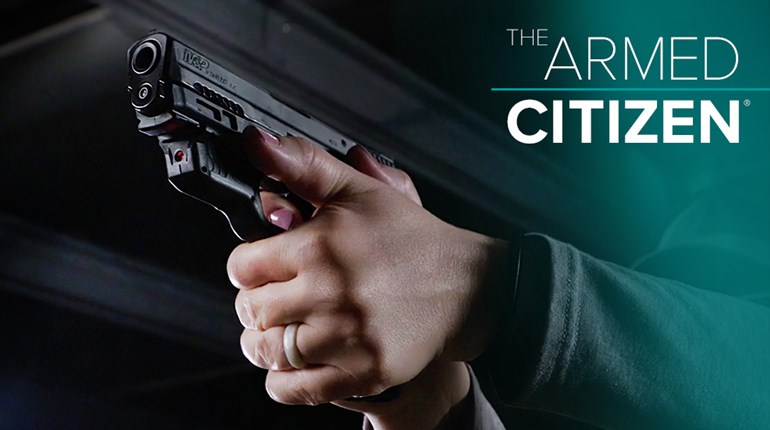
The buckshot versus birdshot debate is practically as old as the first home-defense shotgun, and yet the argument has never really evolved. The pro-buckshot gentleman argues nothing penetrates like 00 buck, while the birdshot proponent argues birdshot minimizes collateral damage because it won't bust through drywall (though some tests indicate that birdshot will indeed penetrate drywall at close-range). Often, the discussion never waivers from these points. However, while penetration is probably the key difference between birdshot and buckshot, there is another important consideration that too often goes unheeded.
Buckshot pellets tend to stick tightly together as they proceed downrange, dumping all of their collective energy into the target. Smaller pellets such as birdshot, on the other hand, have an inherent tendency to spread out more widely. What does this mean for home defense? Let's look at a few photos. All loads were fired from a 12-gauge shotgun with an improved cylinder choke.
Buckshot at 10 yards

First, let's take a look at two photos of buckshot fired from a distance 10 yards—the maximum range at which most self-defense shootings occur, according to law enforcement statistics.
Folks, this is why at inside-the-home distances I'll trust my life to 00 buckshot over anything on the market, handguns and rifles included. Photo No. 1 shows the results of a Hornady Critical Defense load of eight 00 buckshot pellets.

Photo No. 2 is Federal Premium Personal Defense, which contains nine pellets of 00 buckshot. At this distance, both loads dumped the entirety of their energy—essentially the equivalent of four simultaneous .45 ACP handgun rounds—within a 3-inch diameter. Buckshot therefore allows the armed citizen to deliver overwhelming energy to a very specific target. Note also how easy it would be to miss with buckshot. We will save this topic for a future column, but it's worth noting. Those who choose shotguns for home defense because "you can't miss with a scattergun" are misguided. You use a shotgun for home defense because of the energy it harnesses, not as a substitute for range time and practice.
Birdshot at 10 yards
Now let's look at a couple of birdshot loads at 10 yards:

Photo 3 is Remington Lead Game Loads, a 1-ounce load of No. 7 1/2 shot, and photo 4 is B&P MB Classic, a 1 1/8-ounce load of No. 5 shot.

They would likely prove a bad guy's demise at this close proximity (the Remington load packs about 1,400 ft.-lbs. at the muzzle). Note, however, how wide their patterns are already on a 12-inch target. Such patterns are already less likely than buckshot to deliver all of their energy to the bad guy's vitals, and the disparity will only increase with distance. Averaging about 172 ft.-lbs. at the muzzle, an individual 00 buckshot pellet hits harder than a .32 ACP handgun round—just one or two delivered to an intruder would cause him to second-guess his vocation. An average No. 7 1/2 birdshot pellet, however, packs just 4 ft.-lbs. of energy. Therefore, to be effective for home defense, it's imperative for birdshot to impact the target in a highly concentrated pattern. Certainly this can be improved by experimenting with chokes and other loads.
A third birdshot round, Federal Premium Prairie Storm, a 11/4-ounce load of No. 6 shot, displayed a very tight pattern for a game load as seen in photo 5.

It uses the same "FliteControl" wad as Federal's Personal Defense Buckshot load (the VersaTite wad by Hornady Critical Defense is similar). Unlike a conventional wad, the FliteControl design stays with the payload for a longer time and distance, thereby delivering a tighter pattern to the target. It's a great shell for knocking down distant pheasants, and based on this pattern, it would probably stop a home invasion in a hurry. However, it also produced by far the stoutest recoil of any shell tested, buckshot included. Nonetheless, if you insist on using birdshot for home defense, this is perhaps a load worth looking into.
The 25-Yard Test
At 25 yards, birdshot has decreased in effectiveness by a wide margin. A home-defense scenario is less likely to occur at such distance, but these patterns demonstrate a key weakness of birdshot: With every yard, a pattern of birdshot widens incrementally, decreasing its ability to deliver a concentrated blow to burglar-sized vitals.
Additionally, all those pretty holes in the paper in photo 6 may be a bit misleading. Birdshot has slowed quite a bit by the 25-yard mark, so it could take more than a few pellet strikes to get the job done.

The heavier buckshot pellets, on the other hand, still pack plenty of punch at this yardage, and both loads tested dumped 50-75 percent of their pellets into the 12-inch target as seen in photo 7.

Chokes and loads can be tweaked, but as a general rule, the pellets—and therefore the energy—of birdshot widens and disperses over a shorter distance than buckshot. So, if you prefer to use birdshot, proper patterning is absolutely essential to ensure lethality. But, as evidenced by these patterns, delivering energy to the target is generally achieved more easily and effectively with buckshot, which is one of the reasons it remains the most popular choice for defensive purposes.




































